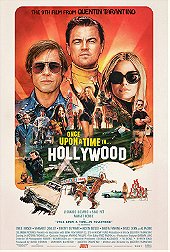Full disclosure: Quentin Tarantino’s cinema is something I’ve never responded to with the reverence and prosaic rhapsody of others. I find his comfortability with certain types of language empty provocations and his increasingly lackluster female characters are certain hardening of grossly masculine outlook. Into this fray comes his ninth film, a paean to the sunset of an era of white male rule and nearly three hours of Tarantino having a midlife crisis.
The story largely concerns Rick Dalton (Leonardo DiCaprio), a former western television star, and Cliff Booth (Brad Pitt), his stunt double and best friend, as they navigate the rise of the New Hollywood and cultural changes of 1969. Orbiting around them are Sharon Tate (Margot Robbie), the Manson family, and various other players that seem to exist merely to threaten their place in the firmament. Being a Tarantino movie it, of course, ends in bloodshed and historical revisionism, like several of his films post-Inglourious Basterds.
I was with Once Upon a Time… in Hollywood elegiac tone and vision for the first two hours but that final forty minutes ruined the entire experience. Sure, up to that point there was a certain hysteria about the presence of non-white people and women, but it was counterbalanced by a humanizing element to Sharon Tate and Pitt’s work as a zen-like figure knowing he’s lost every other relationship in his life. Then Tarantino insists on transforming these guys into heroic figures by killing the Manson family in the most violent ways imaginable.
Frankly, Once Upon a Time would’ve been better had to ended prior to August 1969. It is this ending that solidified the general sense of, as Richard Brody described it, “[celebration of] white-male stardom (and behind-the-scenes command) at the expanse of everyone else.” It’s a bit awe inspiring in how it went from an extended love letter to Hollywood and a mature vision from one of cinema’s enfant terribles before swinging wildly, manically back into his bloodthirsty provocations.
At least DiCaprio and Pitt deliver some truly great work and maintain your interest. DiCaprio creates a portrait of a star struggling to transition from superstar to smaller player that unearths layers of melancholy and vulnerability we haven’t previously seen from the star. There’s a scene where DiCaprio, a great actor, must deliver lines and perform in a manner that’s mannered and artificial, and it’s thrilling to watch him go so far outside of his comfort zone.
But it is Pitt that emerges as the film’s true MVP as he interacts with a larger number of players in the film. He meets his shrinking platform with a benevolent resignation to the charging tides and manages to subtly reflect the internal struggle he’s experiencing throughout. He’s magnetic when merely inhabiting the screen or when sharing it with a crop of up-and-comers, especially in some extended dialogue scenes with Margaret Qualley.
The best scene probably belongs to a nearly silent Margot Robbie as her Sharon Tate goes to watch The Wrecking Crew, a real movie the actual Tate starred in. Robbie-as-Tate watches the real Sharon Tate and for a moment the tragedy that subsumed her movie career is washed away. We’re glimpsing the movie star Sharon Tate, a charismatic beauty that possessed a certain sadness behind her eyes, and her film career is elevated above the tragedy that prematurely ended her life. This is one of the few true moments of elegy and eulogy for a fading Hollywood in a film that ends that maturity with a blowtorch to a swimming pool.
 Login
Login